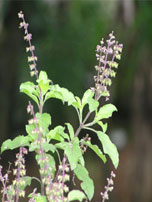SHAHEED KARTAR SINGH SARABHA AYURVEDIC MEDICAL COLLEGE & HOSPITAL
Affiliated to Guru Ravidas Ayurved University, Hoshiarpur Punjab
Affiliated to Guru Ravidas Ayurved University, Hoshiarpur Punjab

Botanical Name : Ocimum sanctum Linn.
Family : Labiatae; Lamiaceae.
Introduction :
Tulasi manily used for preparing cough syrup. It have mainly two variety.
Scientific classification: Basil belongs to the family Lamiaceae (formerly Labiatae). Sweet basil is classified as Ocimum basilicum and bush basil as Ocimum minimum. Mountain mints are classified in the genus Pycnanthemum.
Names in different Indian languages :
English : Indian Basil/Holy basil, sacred Basil
Hindi : Tulsi
Kannada : Krishna Tulsi
Malayalam : Tulsi, trittav, Krishna tulsi
Sanskrit : Tulsi , surasah
Tamil : Tulsi
Telugu : Tulsi
Unani : Tulsi
Synonyms :
Surasaa, Surasa, Bhuutaghni, Suravalli, Sulabhaa, Manjarikaa, Bahumanjari, Deva dundubhi, Apet-raakshasi, Shuulaghni, Graamya, Sulabhaa
Ocimum tenuiflorum Linn.
Classification according to Charaka, Susrutha & Vagbhata :
Charaka
Svãsahara
Susrutha
Surasãdi
Vagbhata
Surasãdi
Varieties & adulterants – (CV – controversy, AD – adulterants) :
1. sukla Tulasi (O. americanum Linn.)
2. Krisna Tulasi (O. sanctum Linn.)
3. O. basilicum— rama tulasi
4. O. minimum
5. O. gratissirnum Linn
6. O. klimendScharicum.— karpoora tulasi
Morphology :
Branched, aromatic under shrub 30-50 cm high, sometimes woody, hairy.
Leaves—simple, opposite, oblong or ovate-oblong, obtuse or acute, – entire or subserrate. Petioles slender hairy
Flowers— very small, borne in terminal and axillary racemes.
Fruits— subglobose or broadly oblong nutlets.
Flowers and fruits almost throughout the year (mainly during September-February).
Habitat & Distribution :
Found throughout India. Now being cultivated extensively.
Chemical Constituents :
eugenol, carvacrol, nerol, eugenolmethylether, Bornyl acetate, cadinene, camphene, camphor, carvacrol, beta-caryophellene, eugenol, eugenol methyl ether, humelene, methyl chavicol, limonene etc.
Properties :
Rasa- Katu, Tikta
Guna -Laghu, Rüksa
Virya – Usna
Vipäka- Katu
Karma Kapha-vãtahara Dipana, Krimighna Putigandhahara
Digestive, diuretic, expectorant, febrifuge, aromatic, carminative, stomachic, antispasmodic, antiasthmatic, antirheumatic, stimulant, hepatoprotective, antiperiodic, antipyretic and diaphoretic
Indications :
Hikkä, Kãsa, svãsa, Visaroga, Parvasüla, Krimi, Visama Jvara.
asthma, cardiopathy, otalgia, bronchitis, hiccough, fever, vomiting, lumbago,skin disease, fever, cough, psychosis
Part Used :
Leaf, root, seed.
Dosage :
Fresh juice 10-20 ml, root decoction 50-100 ml, seed 3-6 g.
External uses :
Because of its insecticidal, deodorant, stimulant, vatahara and oedema relieving actions, the paste of the leaves is useful in chronic ulcers, oedema and pain. Scrubbing of the juice on the skin improves the intradermal circulation. Juice is also used as eardrops in earache.
Internal uses :
Digestive system : Being an appetizer, digestive, laxative and anthelmintic. it is used in anorexia. abdominal pain and helminthiasis. Tulsi seeds are soaked in water and slimy kheer is prepared from it which is given in dysentery. Tulsi leaves should be chewed in pyorrhoea.
Circulatory system : Since it is a cardiac stimulant, blood purifier and anti-inflammatory, it is used in cardiac debility. vatakapha disorders of blood and inflammations.
Respiratory system : Tulsi has a main action on respiratory system. When tulsi leaves are given with honey, they act as an expectorant and alleviate the symptoms like cough induced by kapha. dyspnoea and fever. Tulsi is a very good home remedy for common symptoms like lever, cold and cough.
Urinary system : Tulsi seed is diuretic. It alleviates gonorrhoea, dysuria, burning micturation, cystitis, calculi and also urethritis.
Skin : Diaphoretic, effective in skin diseases, Hence it is used in fever and particularly in ringworm infection, eczema and scabies. The paste of tulsi leaves and black pepper is effective in ringworm infection (It is worn with red. hibiscus flowers in a gadded for Ganeshpooja).
Temperature : Febrifuge. Useful in fever with chills and intermittent fever. Decoction of tulsi leaves is also useful in chronic fever,
Satmikaran : Seed is a tonic, Kheer prepared from the seeds should be used in debility due to pittadosha.
Formulations : Tulsi leaves are being used for trituration in preparing many Ayurvedic formulations. (It may ad as a preservative).
Important Yogas or Formations :
Surasadigana Kasaya, Surasãdi taila, Tumburvãdi yoga, Nimbãdi lepa, Sahacarãdi taila, vilwadi gulika, tulasi patradi tailm.
Important research work going on :
(1) Antifertility activity
(2) Biochemical clearance
(3) Hypoglycaemic effect
(4) Hypo- tensive effect
(5) Mosquito larvicidal as well as mosquito-repellent action
(6) Antibacterial activity
(7) Antifungal activity
(8) Antiviral activity
(9) Anti-stress activity
Therapeutic Uses :
(1) Kaphaja Kasa— Fresh juice of Krishna Tulsi is given with honey (C.S.Ci. 18).
(2) Makkalasula— juice of Tulasi leaves is taken with old jaggery and Manda (G.N.)
(3) Paksmasãta— A copper vessel is impregnated with paste of Puspa Kãsisa mixed with Tulasi juice and left for 10 days. After wards that paste is collected and used as Añjana (A.H.Ut. 9/20).
